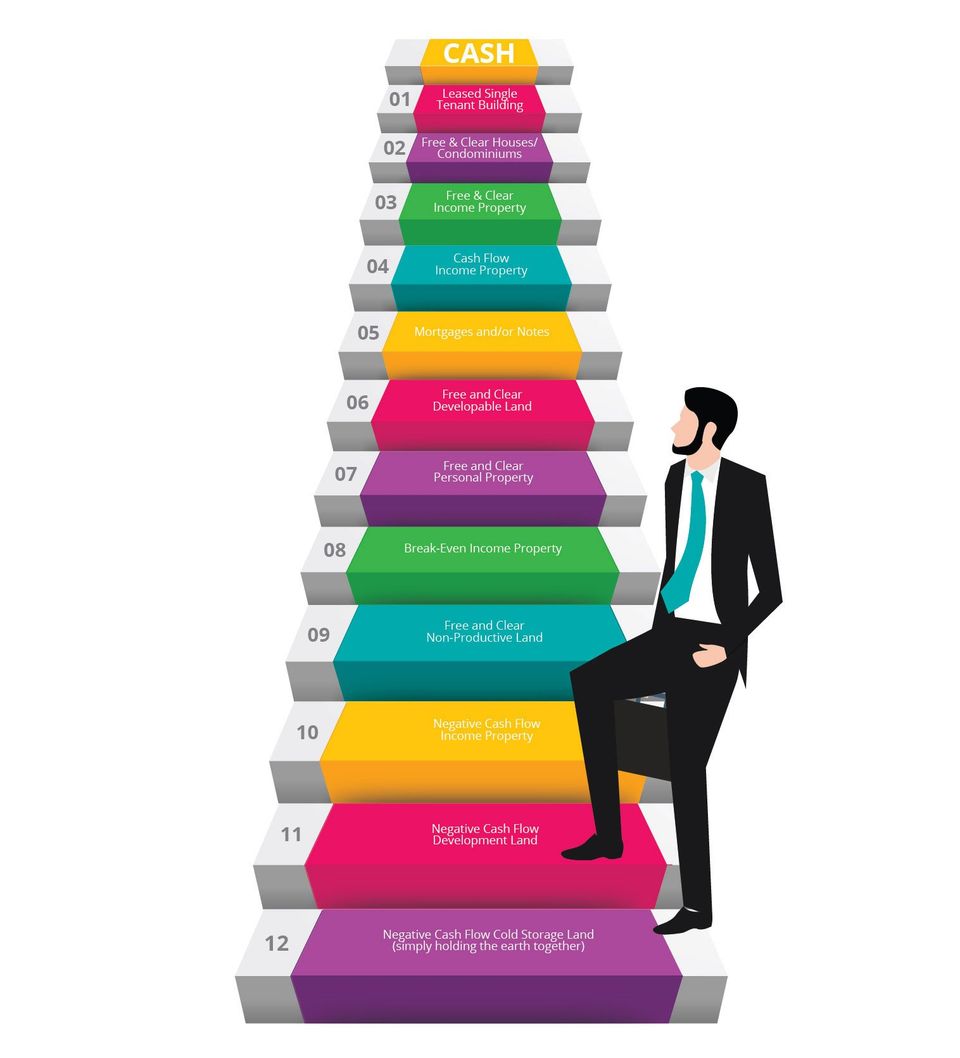EQUITY FUNDAMENTALS
The Stairway of Benefits

By itself, Cash has no value? Initially, a challenging assumption?
There is an argument that Cash is only a medium of barter, and has, by itself, no intrinsic value. It is only a stepping stone to ultimately get what we need or want. Nothing else.
As an example, we may trade in our old model car, plus add Cash to the transaction to drive away with that new model vehicle. Therefore, the transaction exchange to the new vehicle comes from both Cash equity and old vehicle equity. Or, we may drop by the convenience store and give Cash for a quart of milk. Cash is merely the exchange mechanism to get the milk we ultimately need.
In both cases, Cash is, in itself, of little value, except that it helps get us to what is actually wished for or required.
In essence, people or corporations actually want something of intrinsic or direct use or benefit for which the Cash can be offered for.
Therefore, if we know the ultimate goal/motivation of an entity disposing or acquiring a property, it is possible to exponentially multiply the opportunities to complete the transaction and achieve that entity’s objective/goal/need beyond seeking only a Cash transaction? Cash is almost always an intermediate step towards getting to the ultimate benefits required or wanted.
For discussion purposes only, below is a proposed “Ladder of Benefits” model, showing real estate and personal property equities from most desirable to least desirable.
CASH
1. Single tenant building, leased to Macdonald’s for 20 years
2. Free and Clear Houses/Condominiums
3. Free and Clear Income Property
4. Cash Flow Income Property
5. Mortgages and/or Notes
6. Free and Clear Developable Land
7. Free and Clear Personal Property
8. Break-Even Income Property
9. Free and Clear Non-Productive Land
10. Negative Cash Flow Income Property
11. Negative Cash Flow Development Land
12. Negative Cash Flow Cold Storage Land (simply holding the earth together)
For purposes of illustration only, we will stay with this model. However, its order could be debated. As an example, some may put good quality mortgages up to a #1 or #2 category, instead of down at #5. In the end, different preferences prevail.
DISCUSSION RATIONALE
A brief explanation of the order.
- Number one could quickly be sold for more cash than 100%.
- Houses/Condominiums can probably be immediately financed for 70 to 90% and traditionally sell quickly.
- Income property can usually be financed for 60-70% of value and produce obvious cash flow.
- Mortgages can be hypothecated, or sold at a discount, depending on quality.
- A buyer can usually be found for developable land.
- Personal property (boats/cars etc.) can be fun.
- The free and clear nonproductive land does nothing for the new owner one way or the other, except beef-up his financial statement, while the negative cash flow income property hurts.
So, in theory, it should be easy to convince yourself to make the move up or down the property ladder.
MOVE DOWN IDEAS
Creative Solution based real estate structuring makes it beneficial for the higher number to move down. Here are a few ways to economically move down the ladder.
- a. Find a User - For instance, a developer with cash flow income property (#1 to #4) might very well take negative cash flow land (#11) if he could develop it.
- b. Go Passive - A person with cash flow income property (#4) or even free and clear income property (#2 or #3) might take paper (#5).
OTHER IDEAS
- c. Change Use - Having a solution to negative cash flow problem (Number 11) can change to a #8 or #4, making it desirable for the numbers in between.
- d. Make the Property More Attractive - Take off the loans or offset them. You can change negative cash flow land and income properties to break even or even cash flow.
- e. Sweeten - Negative cash flow, cold storage land is hard to swallow by itself. However, a completely different taste is brought about by adding sufficient cash, paper, etc. Other, less desirable properties can advance in acceptability when sweetened.
- f. Solve the Other Party’s Problem - The willingness to take on and solve problems on another’s potentially more desirable property often can be the factor that will make a creative transaction work. Examples: Finding users for vacant homes, condominiums, hotels, etc. using management expertise to solve vacancy problems; financial muscle to refinance an over encumbered property or one with short-term loans; willingness to take on a property in litigation; willingness to work out title problems; willingness to develop out all, or part, of a property; willingness to make payments while locating a tenant (feeding the eat).
Where there are challenges, there are solutions. However, to be effective we must also be creative and practical.
Remember. There is no bad real estate, only inappropriate or untimely ownership.
Solution Based Consulting
Consulting services are available upon request. Please contact us to learn more.


